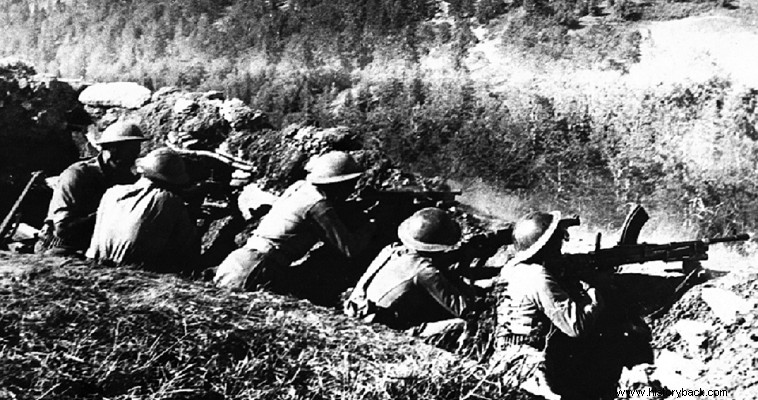
The Greek infantry was called to participate in the fratricidal conflict, which came to be known as the Civil War. He also fought in this, the first hot conflict of the Cold War, with his well-known bravery, unfortunately against brothers.
The civil conflict that bloodied Greece in the period 1946-49 had, in fact, started since 1943, both in the Greek mountains and in the Middle East - with the well-known movements. However, it peaked in the period 1946-49.
Protagonists in this conflict were, on the one hand, the rebels of the "Democratic Army of Greece" (DSE) and, on the other, the ordinary infantrymen of the Greek Army - and not, as is wrongly stated, of the "Government Army", since armies, as is known , form states and nations and not governments.
The Greek Infantry, at the beginning of the period in question, was made up of conscripts, with no combat experience and few trained men of the 3rd Mountain Brigade. Some men had also fought in various resistance organizations. The level of training was initially low, due to the need to immediately deploy the divisions to the fight.
Also, due to the nature of the struggle as such (guerrilla war), but also because of the particular form of the struggle (civil war), morale was not particularly high. This was also contributed to by the appalling shortages of heavy infantry weapons and especially machine guns.
The basic combat unit was the Infantry Battalion (IP). The Battalion consisted of three rifle companies and one heavy weapons company. each rifle company had three rifle platoons and one command platoons. The battalion's heavy weapons company, in theory, was to have three machine gun platoons (12 machine guns) and a 81mm mortar platoon (4 tubes).
But in reality it did not have a single machine gun and usually had up to two mortars. Rifle platoons also had one Bren machine gun per battle group and a light mortar, 50mm, initially British and 60mm, later American.
The lack of machine guns was a daunting problem for the Greek Infantry, which was not fully resolved until the end of the Civil War. The British, who until 1947, had undertaken the reconstruction of the Greek Army, had only 96, in total, water-cooled Vickers machine guns of 0.303 in. Seven machine gun companies were formed with these weapons, one for each Infantry Division.
On the other hand, each DSE battalion, although with a numerical strength equal to almost half of the Army battalions, had a greater number of automatic weapons - machine guns, submachine guns - and sometimes mortars.
Infantry battalions had to field 800 men. In fact they rarely exceeded 600. Usually their numerical strength was between 400 and 500 men. The basic weapon of the Infantry was the British Lee Enfield repeating rifle, caliber 0.303in.
Officers and non-commissioned officers carried Sten and Thomson submachine guns and pistols or revolvers. Even after the USA took over the responsibility of supplying the Greek Army, no spectacular progress was made regarding the equipment of the Infantry.
Only the Mountain Commando Companies (MOCs) began, from 1948, to be supplied with American equipment – M-1 rifles, 0.30in Browning machine guns. and M-3 submachine guns. In common infantry units, 0.30in Browning machine guns began to become available in the latter stages of the conflict. M-1 rifles were not made available until after the end of the Civil War.
The Infantry was organized, throughout the Civil War, on British standards, into Infantry Brigades, each of which extended three battalions of infantry and theoretically had an organic artillery or heavy mortar section and a machine gun company. In the absence of mountain artillery, heavy mortars and machine guns, usually each Brigade extended only its three infantry battalions, thus corresponding, altogether, to a simple infantry regiment.
The Infantry assumed, as expected, the brunt of the struggle, during the Civil War, existing and the greatest bleeding. The first unfortunate operations, the fight against an "invisible" enemy, who had the initiative of the movements and the reluctance of the command, which also had no experience in the counter-insurgency fight, resulted in the Infantry not performing as expected, in beginning at least, despite the bravery and courage of officers and soldiers.
When the later marshal Papagos took command, at the beginning of 1949, he managed to breathe new life into the Army, recreating, as it was called at the time, the "Army of Albania". With the new aggressive spirit that prevailed, the Infantry managed, essentially, to end the fratricidal war, raising the Greek flag again on the mountain tops of Grammos and Vicis.
